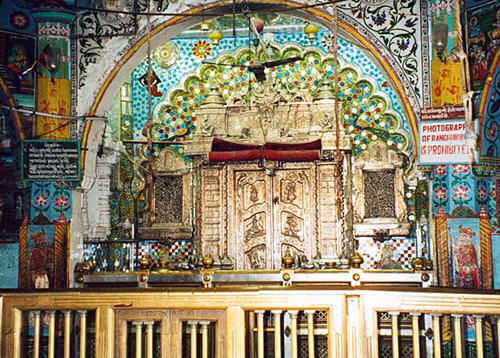
http://www.youtube.com/watch?v=jpZK2RFcDd8&feature=player_detailpage
The temple normally opens at about 6 A.M. in the morning and closes at 12 Noon between which there are five darshans namely Mangalbhoga, Balbhoga, Sringarbhoga, Gwalbhoga and Rajbhoga during which Aartis are performed. In the afternoon, it reopens at about 4.00 pm and closes at 7.00 pm. In between there are three darshans namely, Uthapanbhoga, Shayanbhoga and Shakhtibhoga. At Utthapana Bhoga and Shayana bhoga, aaratis are performed. The Darshana timings on full moon days are different and are declared by the temple authorities beforehand. Bhogas worth approximately rupees seven thousand per day are offered to the Deity and are taken over by the sevakas (priests) who supply the prasad to the pilgrims and devotees. For the convenience of the vaishnavas desirous to offer additional bhogas to the Deity except the scheduled ones, there is a provision in the Dakor Temple Scheme and accordingly Mahabhoga, Rajbhoga and additional bhogas are offered to the Deity. For all such extra bhogas, the devotees can receive prasad except Rajbhoga, through Dakor Sansthan Trust which is the oldest bhoga of the time when the Deity Shree Ranchhodraiji was installed in this temple i.e. when the Pran Pratishtha was performed.
Mangala Darshan is the first darshan of the day at dawn. The Bhavana (emotion) of waking Lord Ranchod Rai Ji with the same affection and love of his mother Yashoda, when at Gokula is represented in this Darshan. The name Mangala underlines the auspiciousness of beginning the day with a glimpse of the Lord.
Shringar Darshan is usually 45 minutes after the Mangala Darshan. His attire depends on the day and the month according to the Lunar Calendar. Ranchod Rai Ji is adorned with a garland of flowers around his neck. The Lord is shown a mirror to see himself. He is offered dry fruits and sweets after which the flute is placed over his shoulder to imply that the Lord can now go out to play with his friends.
After the Shringar Darshan, is a Gwal Darshan during which the Lord takes his mid-morning snack, curd and light food is offered to him during this darshan. Gwal darshan depicts the time when Lord Ranchhod ji takes his cows to the pasture and plays with his friends. Neither garland nor flute is placed on his shoulder as he is playing with his cowherd friends.
The main meal of the day is offered to Ranchod Rai Ji during this darshan. He is adorned with lotuses, a flower garland and his flute. Perfume of the season is sprinkled. The sounds of drums and devotional music fill the air and the excitement mounts as the aarti is performed. After this, he retires for three hours representing the siesta he enjoyed in the meadows.
In the Utthapan darshan which is at mid afternoon, Lord Ranchod Rai Ji is lovingly awakened from his afternoon nap.
The Shayan Darshan is the last Darshan of the day, when Lord Ranchod Rai Ji finishes a light meal. A fan made of peacock feathers is waved to avoid the effects of any evil eye cast while he is in full view of the people.


